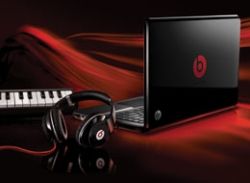5 Tips for Quality Notebook Audio

Between streaming tunes via Pandora, watching your favorite shows on Hulu, and all of your iTunes downloads, your notebook is a mini media center. But while it’s easy to identify a high-quality display for watching HD movies, finding a laptop with sweet sound can be hit or miss. Here’s how to hit a bullseye.
What To Look For:
Speaker Placement and Separation
Good speaker placement is easy to identify. Look for laptops with speakers positioned either around the keyboard, along the front-facing rim, or in the display bezel. These locations send sound in your direction. While that would seem like a no-brainer, some notebooks house speakers in the base of the device, where a desk surface or lap can easily muffle the output. Also look for separation between the two speakers. Extreme placement to the left and right is imperative for proper 2.0 channel audio, or input designed to be delivered across two distinct output sources.
Other tips: Branded Custom Speakers, Dolby and SRS Digital Sound Software, Vetting Output, and Testing Driving Speakers.
Branded Speakers
Notebook vendors often partner with independent speaker manufacturers and digital sound engineering firms to custom-fit notebooks with top-tier audio components and software. The HP Pavilion line, for example, comes exclusively with sound systems designed by Altec Lansing. Meanwhile, the 18-inch Toshiba Qosmio X500 boasts built-in Harmon Kardon speakers. While such solutions deliver a bolstered audio experience the majority of the time, they’re by no means a sure shot. For instance, the ASUS UL50VF ships with speakers designed by Altec Lansing, but we found the volume to be unimpressive.
Stay in the know with Laptop Mag
Get our in-depth reviews, helpful tips, great deals, and the biggest news stories delivered to your inbox.
Dolby and SRS
Notebook makers often partner with software engineers such as Dolby or SRS to outfit their machines with substantial audio power. Both take a digital approach to the playback problem by mitigating the imperfections of hardware speakers and manipulating soundwaves via a set of complex algorithms installed in the notebook’s audio driver.
Though it can’t work the miracle of transforming stereo (two-speaker) audio into a true surround experience (at least not without plugging your notebook into a 4.1-channel or higher home audio setup), Dolby’s Advanced Audio product can use the multichannel input from Blu-ray discs or DVDs to create a virtual surround sound experience. SRS’ Premium Sound package offers the same capability with its TruSurround XT technology. Headphone 360, another feature within SRS Premium Sound, rechannels audio input for a more enveloping experience with headphones. Dolby Headphone achieves a similar effect.
Overall, Dolby and SRS are closely matched in terms of the sound customization options they offer and the quality boost they afford. We watched an HD trailer for Daybreakers on a Dell Inspiron 14 with SRS Premium Sound and an Acer Aspire 5740G with Dolby Home Theater. Special effects boomed from each respective system, and background music was crisp. With enhancements turned off, dialogue, music, and special effects were muddy.
Output
Most notebooks max out at 2.1-channel output (two speakers and a subwoofer). That’s far from a con; the Dell Studio 17, for instance, is a larger media machine geared toward HD fans. Its two JBL speakers and baked-in subwoofer are sure to impress. Other systems, such as the multimedia-oriented Acer Aspire 8940G, offer 5.1-channel audio, which includes five integrated speakers and a built-in subwoofer. If a notebook is saddled with dim sound despite these specs, we recommend external speakers such as the Creative Inspire T6160 ($80), a six-piece set with five satellite speakers and a subwoofer that will satisfy media buffs.
Test Drive the Speakers
If you’re an audio-centric notebook shopper browsing machines in a brick-and-mortar store, ask the sales representative if you can play an MP3 file from your own USB drive. Or see if they’ll let you fire up Pandora, Slacker, or any music site in the browser to gauge a machine's volume and sound quality. Listen not just for volume but for any distortion as you reach the maximum level. If you can, also try sites like Hulu to gauge the crispness and volume of dialogue. You’ll be surprised by how different, yet similar-looking, notebooks can sound.
